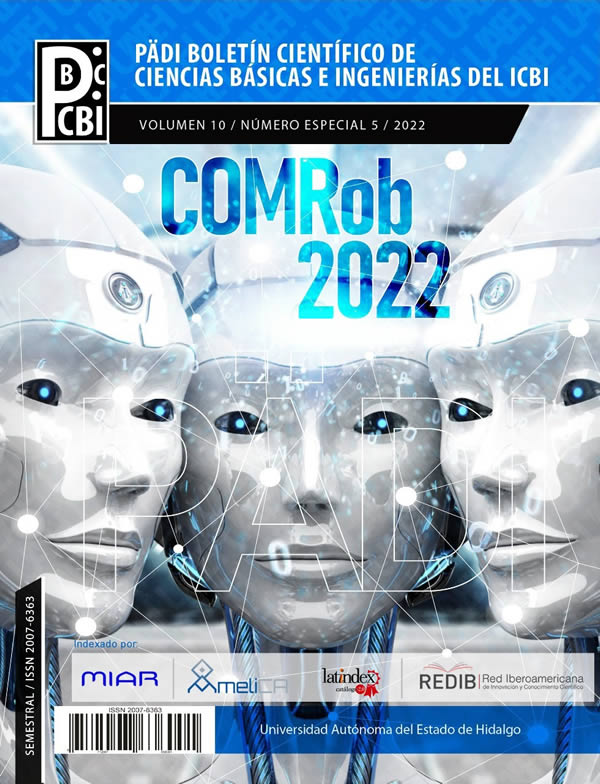Experimental blood glucose estimation from photoplethysmography recordings on distal finger phalange
DOI:
https://doi.org/10.29057/icbi.v10iEspecial5.10074Keywords:
glucose, interphase, near-infrared, PhotoplethysmographyAbstract
Blood glucose concentration shows the quality and health of an individual. High glucose levels in the blood flow indicate atypical behavior of the human system. Currently, there is an acceptable test method to estimate glucose level; it consists in taking out a blood sample by the finger with a pin prick. However, the blood sample test has some disadvantages because it can produce some non-desired issues, such as infections, especially a typical case in people living with diabetes. Therefore, this work is motivated by applying reflective Photoplethysmography (PPG), a non-invasive technique based on a light source and a photodetector near the human body's skin. In this case, we propose two different blood glucose sensors using the infrared diodes LTE-302 and COM-09349 with a photodetector FDS-100. It is worth noting that both designs have multiple development stages, and all of them are self-designed and validated through various test samples with three healthy volunteers, one woman and two men. The results present an error of about 14 % for the first sensor, while for the second sensor is about 7.9 %. Moreover, the sensor measurements are compared against a commercial glucometer, the One Touch Select Plus Flex, and the specifications of the NORM ISO 15197:2013 standard. Finally, the reflective PPG technique could be applied as a non-invasive method to estimate the blood glucose level in the human body.
Downloads
Publication Facts
Reviewer profiles N/A
Author statements
Indexed in
- Academic society
- N/A
References
Basto-Abreu, A., López-Olmedo, N., Rojas-Martínez, R., Aguilar-Salinas, C. A., De la Cruz-Góngora, V., Rivera-Dommarco, J., ... & Barrientos-Gutiérrez, T. (2021). Prevalencia de diabetes y control glucémico en México: resultados nacionales 2018 y 2020. Salud Pública de México, 63(6), 725-733.
Basto-Abreu, A., Barrientos-Gutiérrez, T., Rojas-Martínez, R., Aguilar-Salinas, C. A., López-Olmedo, N., Cruz-Góngora, V. D. L., ... & Villalpando, S. (2022). Prevalencia de diabetes y descontrol glucémico en México: resultados de la Ensanut 2016. salud pública de méxico, 62, 50-59.
Chincoya, G. S., Oliva, G. M., & Oria, J. I. C. (2021, November). Dispositivo de Monitoreo de Glucosa en Sangre No Invasivo mediante Infrarrojo Cercano. In Memorias del Congreso Nacional de Ingeniería Biomédica (Vol. 8, No. 1, pp. 173-177).
Covarrubias-Macías, E. (2022). Estudio de fotopletismografía reflectiva para la estimación de glucosa basado en infrarrojo cercano. Revista Aristas, 9(17), 302-307.
Inés de Mir Messa, Olaia Sardón Prado, Helena Larramona, Antonio Salcedo Posadas, and José Ramón Villa Asensi, "Body plethysmography (I): Standardisation and quality criteria," Anales de pediatria, vol. 83, no. 2, pp. 136.e1-7, 2015.
Breitenbeck, N., & Brown, A. (2017). Accuracy assessment of a blood glucose monitoring system for self-testing with three test strip lots following ISO 15197: 2013/EN ISO 15197: 2015. Journal of Diabetes Science and Technology, 11(4), 854-855.
Briseño-Castellanos, M., Hernández-Gonzalez, M. A., Ramos-Moreno, J. M., Cisneros-Carrasco, J. M., & Jiménez-Ruvalcaba, J. (2021). Determinación niveles de glucosa por medio de espectroscopía como método no invasivo. Revista Médica del Instituto Mexicano del Seguro Social, 59(6).
Bruen, D., Delaney, C., Florea, L., & Diamond, D. (2017). Glucose sensing for diabetes monitoring: recent developments. Sensors, 17(8), 1866. Adaobi, O. O., Iwueze, I. S., Biu, E. O., & Arimie, C. O. (2021). On the analysis of blood glucose levels of diabetic patients. Fortune Journal of Health Sciences, 4(1), 257-283.
Kim, J. H., Garo, M. L., Guerra, A., Paparo, M. T., & Russo, A. (2021). Accuracy of Two CE-Marked Blood Glucose Monitoring System Based on EN ISO 15197: 2015. Diabetology, 2(4), 232-239.
Liu, M., & Zhang, C. (2021, October). Design of Control System of Indoor Energy-saving Lamps Based on Microcontroller. In 2021 3rd International Conference on Artificial Intelligence and Advanced Manufacture (pp. 270-275).
Pleus, S., Baumstark, A., Jendrike, N., Mende, J., Link, M., Zschornack, E., ... & Freckmann, G. (2020). System accuracy evaluation of 18 CE-marked current-generation blood glucose monitoring systems based on EN ISO 15197: 2015. BMJ Open Diabetes Research and Care, 8(1), e001067.
Schwarz, Y., Konvalina, N., & Tirosh, A. (2021). A Pilot Trial to Evaluate the Accuracy of a Novel Non-Invasive Glucose Meter. Sensors, 21(20), 6704.
Shelley, K., Shelley, S., & Lake, C. (2001). Pulse oximeter waveform: photoelectric plethysmography. Clinical monitoring, 2.
Siegmund, T., Heinemann, L., Kolassa, R., & Thomas, A. (2017). Discrepancies between blood glucose and interstitial glucose—technological artifacts or physiology: implications for selection of the appropriate therapeutic target. Journal of diabetes science and technology, 11(4), 766-772.
Sun, H., Saeedi, P., Karuranga, S., Pinkepank, M., Ogurtsova, K., Duncan, B. B., ... & Magliano, D. J. (2022). IDF Diabetes Atlas: Global, regional, and country-level diabetes prevalence estimates for 2021 and projections for 2045. Diabetes research and clinical practice, 183, 109119.
Tang, L., Chang, S. J., Chen, C. J., & Liu, J. T. (2020). Non-invasive blood glucose monitoring technology: a review. Sensors, 20(23), 6925.
Vázquez-López, Carlos E., Gamboa-Loaiza, Diana, Covarrubias-Macías, E. (2022). Estimacion del nivel de glucosa mediante fotopletismografía aplicando el infrarojo cercano. Robótica y Computación, una Nueva Perspectiva, 27-32.




















